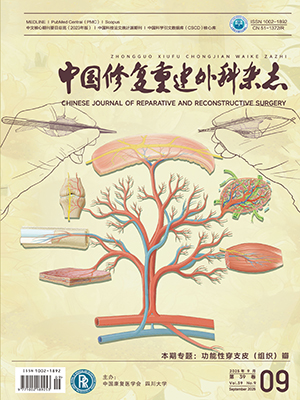OBJECTIVE: To repair esophageal defects with an artificial prosthesis composed of biodegradable materials and nonbiodegradable materials, which is gradually replaced by host tissue. METHODS: The artificial esophagus was a two-layer tube consisting of a chitosan-collagen sponge and an inner polyurethane stent with a diameter of 20 mm and a length of 50 mm. We used the artificial esophagus to replace 5 cm esophageal defects in group I (five dogs) and in group II (ten dogs), and nutritional support was given after operation. The inner polyurethane stent was removed after 2 weeks in group I and after 4 weeks in group II endoscopically and epithelization of the regenerated esophagus was observed by histologic examination and transmission electron microscope. RESULTS: In group I, the polyurethane stent was removed after 2 weeks, and partial regeneration of esophageal epithelial was observed; and constriction of the regenerated esophagus progressed and the dogs became unable to swallow after 4 weeks. In group II, the polyurethane stent was removed after 4 weeks, highly regenerated esophageal tissue successfully replaced the defect and complete epithelization of the regenerated esophagus was observed. After 12 weeks, complete regeneration of esophageal mucosa structures, including mucosal smooth muscle and mucosal glands and partial regeneration of esophageal muscle tissue were observed. CONCLUSION: Esophageal high-order structures can be regenerated and provided a temporary stent and support by polyurethane stent and an adequate three-dimensional structure for 4 weeks by collagen-chitosan sponge.
Citation: QIN Xiong,XU Zhi fei,ZHAO Xue wei,et al.. RECONSTRUCTION OF A CERVICAL ESOPHAGUS SEGMENT WITH AN ARTIFICIAL PROSTHESIS BY USE OF A POLYURETHANE STENT COVERED WITH COLLAGEN-CHITOSAN SPONGE IN DOGS. Chinese Journal of Reparative and Reconstructive Surgery, 2003, 17(5): 374-378. doi: Copy
Copyright © the editorial department of Chinese Journal of Reparative and Reconstructive Surgery of West China Medical Publisher. All rights reserved




